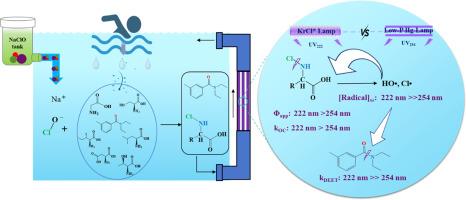Simultaneous Control of Organic Chloramines and Emerging Contaminants in Swimming Pool Water Using Far-UVC Irradiation
IF 12.4
1区 环境科学与生态学
Q1 ENGINEERING, ENVIRONMENTAL
引用次数: 0
Abstract
Organic chloramines (OCs) formed during chlorination of amino acids in swimming pool water, alongside emerging contaminants such as personal care products, pose health risks to swimmers. This study proposes a novel approach for simultaneous control of OCs and trace contaminants using far-UVC irradiation. Results demonstrate enhanced photodecay of OCs, radical production, and contaminant degradation when replacing conventional low-pressure mercury UV lamps (UV254) with krypton chloride excimer lamps (UV222). The UV fluence-based photodecay rate constants of six OCs are 1.00–1.83-fold higher under UV222 (7.44 × 10–4 to 3.28 × 10–3 cm2 mJ–1) than under UV254 (3.78 × 10–4 to 2.34 × 10–3 cm2 mJ–1). This enhancement primarily results from higher apparent quantum yields (1.78–5.51-fold increase), rather than molar absorption coefficients. Furthermore, steady-state concentrations of hydroxyl radicals (HO•) and chlorine radicals (Cl•)—normalized to incident fluence rates—are 1.00–1.86-fold and 2.35–5.32-fold higher under UV222 than under UV254, respectively. In actual swimming pool water, UV222 rapidly degrades N,N-diethyl-meta-toluamide (DEET) through synergistic radical pathways, whereas UV254 exhibits negligible degradation. These findings advance the photochemistry of OCs and establish far-UVC as a promising technology for simultaneous control of OCs and trace contaminants in chlorinated swimming pools.

远紫外线辐射同时控制游泳池水中有机氯胺和新出现的污染物
游泳池水中氨基酸氯化过程中形成的有机氯胺(OCs),以及个人护理产品等新出现的污染物,对游泳者的健康构成威胁。本研究提出了一种利用远紫外辐射同时控制有机碳和微量污染物的新方法。结果表明,当用氯化氪准分子灯(UV222)取代传统的低压汞紫外灯(UV254)时,OCs的光衰、自由基的产生和污染物的降解都得到了增强。与UV254(3.78 × 10-4 ~ 2.34 × 10-3 cm2 mJ-1)相比,UV222(7.44 × 10-4 ~ 3.28 × 10-3 cm2 mJ-1)下6种oc的紫外荧光光衰减速率常数高1.00 ~ 1.83倍。这种增强主要是由于更高的表观量子产率(增加1.78 - 5.51倍),而不是摩尔吸收系数。此外,羟基自由基(HO•)和氯自由基(Cl•)的稳态浓度(按入射通量归一化)在UV222下分别比UV254高1.00 - 1.86倍和2.35 - 5.32倍。在实际的游泳池水中,UV222通过协同自由基途径快速降解N,N-二乙基-间甲苯酰胺(DEET),而UV254的降解作用可以忽略不计。这些发现促进了OCs的光化学,并确立了远紫外线作为同时控制氯化游泳池中OCs和微量污染物的一种有前途的技术。
本文章由计算机程序翻译,如有差异,请以英文原文为准。
求助全文
约1分钟内获得全文
求助全文
来源期刊

Water Research
环境科学-工程:环境
CiteScore
20.80
自引率
9.40%
发文量
1307
审稿时长
38 days
期刊介绍:
Water Research, along with its open access companion journal Water Research X, serves as a platform for publishing original research papers covering various aspects of the science and technology related to the anthropogenic water cycle, water quality, and its management worldwide. The audience targeted by the journal comprises biologists, chemical engineers, chemists, civil engineers, environmental engineers, limnologists, and microbiologists. The scope of the journal include:
•Treatment processes for water and wastewaters (municipal, agricultural, industrial, and on-site treatment), including resource recovery and residuals management;
•Urban hydrology including sewer systems, stormwater management, and green infrastructure;
•Drinking water treatment and distribution;
•Potable and non-potable water reuse;
•Sanitation, public health, and risk assessment;
•Anaerobic digestion, solid and hazardous waste management, including source characterization and the effects and control of leachates and gaseous emissions;
•Contaminants (chemical, microbial, anthropogenic particles such as nanoparticles or microplastics) and related water quality sensing, monitoring, fate, and assessment;
•Anthropogenic impacts on inland, tidal, coastal and urban waters, focusing on surface and ground waters, and point and non-point sources of pollution;
•Environmental restoration, linked to surface water, groundwater and groundwater remediation;
•Analysis of the interfaces between sediments and water, and between water and atmosphere, focusing specifically on anthropogenic impacts;
•Mathematical modelling, systems analysis, machine learning, and beneficial use of big data related to the anthropogenic water cycle;
•Socio-economic, policy, and regulations studies.
 求助内容:
求助内容: 应助结果提醒方式:
应助结果提醒方式:


